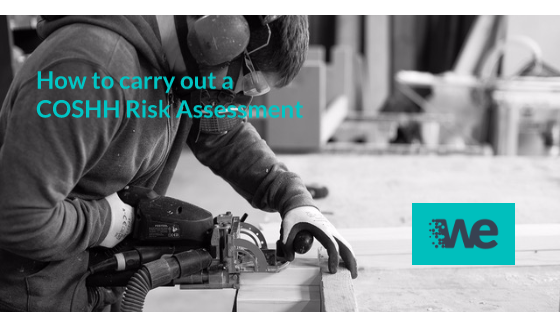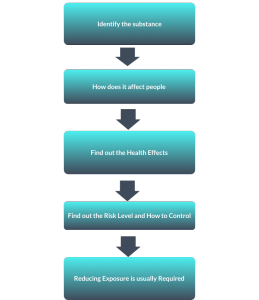How to carry out a COSHH Risk Assessment
In an earlier post we explained what a COSHH Risk Assessment was, but how do you carry one out, and what’s involved. in this article we provide a quick guide to carrying out your COSHH Risk Assessment in six easy steps. This particular example looks at the use of a belt sander and the potential for personal exposure to wood dust. There’s also examples of the type of wording that you could use in the assessment.
1 – Identify the Substance
Question – What is the substance of concern?
What to do – Assess the activity and observe where the substance comes from during the process.
Example – “Wood dust comes from the sanding process.”
2 – How does it affect people
Question – Who might be harmed and how?
What to do – Watch the process during normal, cleaning and maintenance tasks. Write down which tasks and job roles are affected.
Example – “Wood dust is emitted from the belt sander machine and moves toward the worker operating the machine. Other people are also affected as it builds up on the floor, below the machine. It was observed to blow around when the door is open. Workers clean up daily using sweeping brushes, which moves the dust into the air. When the machine is opened to change the sanding belt, dust falls out of the machine onto the clothing of the maintenance worker.”
3 – Find out the health effects
Question – What are the health effects?
What to do – Check the safety data sheets, any relevant supplier information. The HSE website is also a good source of information. Then list the health effects. For example, wood dust can cause occupational asthma and skin irritation.
Example – “Wood dust, if enough is breathed in by workers, this can be the cause of occupational asthma and skin irritation. If hard wood dust is present, then there is cancer potential.”
4 – Find out the Risk Level and How to Control Exposure
Question – is the risk of exposure low, medium or high?
What to do – Find out the chance of exposure happening. Workplace air monitoring may reveal useful information and will help with improving the control of the process. If it is not controlled at the source of emission, then control the chance of exposure by other means.
Example – “Air monitoring has been booked in for next month, to measure wood dust exposure for sanding and cleaning tasks, during which the working practices will be observed. From this information, we will then know the risk level of exposure for normal and cleaning tasks and how to reduce exposure for staff.”
5 – Reducing Exposure is usually required
Question – how can exposure to the substance be reduced to ensure it is low?
Answer – Look at how to reduce exposure if not already low. Watch and observe the process, ask other staff for ideas, look at trade body information. Look at the HSE website www.hse.gov.uk/coshh and www.breathefreely.org.uk for that particular substance. Get external, specialist help if needed.
Example – “As a result of the air monitoring, the assessment aims to find out exactly where the dust is emitted from on the machine, and provide suggestions on how to stop, or capture, then remove the dust. Information leaflets have been found on the HSE website about sanding machines, these point out where to fit extraction that should work to remove the dust. Extraction companies will be contacted to get quotes to fit the extraction. Suitable dust masks will be used at the sander as a short term measure until extraction is fitted and shown to reduce dust emissions.
It’s essential to complete the task – Write down your considerations and most importantly act of the conclusions. If you need any help with carrying out your COSHH Risk Assessments, or want assistance in reviewing existing Risk Assessments we’re here to help.
Our approach
Get in touch with Workplace Exposure, either give us a call on 0800 689 4386, or fill in our enquiry form to discuss your monitoring or consultancy requirements.
We’ll then provide you with a no obligation proposal, we can often give an initial idea of fees whilst we discuss your needs.
Once you’ve accepted our proposal we can then schedule the work.
Following our site visit we’ll provide you with a comprehensive report giving you advice, recommendations and control measures where appropriate.
Implement the outcomes for compliance and a happier healthier workplace.

